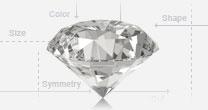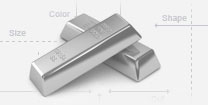- Diamonds
- Engagement
- Jewelry
- Education
- Learn about Diamonds
- Learn about Metals
- What to expect when buying a ring
- Custom Design Process
- The Diamond 4 C's
- How To Care For Your Jewelry
- How To Plan A Wedding
- Picking an Engagement Ring
- Top 10 Ways To Propose
- The Meaning Behind Shapes and Colors of Diamonds
- Advice for Grooms
- The Natural History, Mythology, and Symbolism of Popular Gemstones
- The Bridal Style Checklist
- The Economics of Engagement Rings
- How to Keep Your Diamonds Safe from Theft or Damage
- How to Create the Perfect Christmas Proposal
- The Secret Guide for Authentic Engagement Photos
- How to Plan the Perfect Marriage Proposal
- Best Seasons to Get Married In
- About Us
Diamond Carat Weight Guide
What is a Carat?
A carat is a unit of weight that equates to exaclty 200 milligrams. Carats are the principal unit of measurement that is used to weigh gems. The word is derived from the Greek word keration, meaning carob beans. In ancient times the carob beans were thought to be of uniform weight and were used used to weigh various goods including precious gems. Asian markets have used rice grains to weigh gems and there are some jewelers who still refer to a once carat diamond as a "four grainer" as it was believed that four grains of rice roughly equalled the weight of a single carat. Using the metric system the industry refers to 0.01 of a carat as a "point", so for example a 0.50 Ct. diamond would be referred to as a 50 point diamond or a "50 pointer".
Does Carat Weight Determine Size?
While it is certainly true that the carat weight of a diamond has a significant impact on its size, its carat weight does not tell the full tale of the diamond's perceived size. Since the diamond is a three-dimensional object, the distribution of the diamond's weight has a large impact on the diamond's perceived size. In round diamonds for instance, two diamonds of equal weight can face-up showing a 0.20-0.30 Ct. difference from the counter-part deeper option. In some fancy shapes such as the pear or marquise, the depth of the and length-to-width ratio of the diamonds can cause two equal weight diamonds to appear over 1.0 carat different in appearance. To understand how large the diamond appears always look at its millimeter dimensions.
Some lower carat weight diamonds with high grade cuts look significantlylarger than high carat diamonds with low grade cuts. Diamonds with higher cut grades will reflect the maximum amount of light and exhibit the greatest fire and brilliance. This sparkle and light-intensity resulting from a well-cut diamond can cause the diamond to appear larger than it is. There are some diamonds will lower cut grades that have long and deep pavillions that cause light to not be returned properly when it leaks out the bottom of the deep pavillion. This effect causes the diamond to appear less brilliant and muted. These long-pavillioned deeper diamonds will appear smaller when compared to well cut diamonds of equal weight.
Carat Weight and Price
Diamonds prices increases exponentially as their carat weight is increased. It is exponentially more difficult to find rough diamond in nature that can be used to cut a finished diamond that is larger and of equal color and clarity when compared to a smaller weight diamond. One the most important principles that governs the increased price of diamonds as the weight increases, is that diamonds increase exponentially in price but in the form of a step-function. The tool that is used to establish the price of diamonds in the wholesale markets is called the Rapaport Diamond Report. The report establishes pricing tables for diamonds where every new carat weight table brings with it a significantly higher price for the same quality of diamond. For instance, the Rapaport Diamond Report predicts that a 1.00-1.49 Ct. round diamond that is of H color and SI1 clarity will run 29.8% less than a 1.50-1.99 Ct. round diamond of the same quality. Knowing the step-function nature of the pricing will enable the prospective customer to specifically track down a diamond that is 1.25-1.49 Ct. where the diamond spreads larger than the straight 1.00 Ct. but prices 29.8% less than the 1.50 Ct. diamond.
Choosing a Carat Weight
Buying a diamond involves thinking through a series of trade-offs. Some people value size more than color, and others value clarity more than either size or color. We find that he most important things to consider are personal taste, setting, budget, and finger size.
- Personal Taste: Decide what trade-offs you want and which of the 4C's you value most.
- Setting: Longer shaped diamonds such as pears and marquise diamonds can create larger appearances as the eyes of its admirers are drawn to the length of the diamond. A high-pronged setting or a slender ring can also create a very large appearance for the diamond. The sharp tipped shapes such as princess cuts, pears, and marquise diamonds, will often require a v-tipped prong to protect its corner that will make the diamond appear larger as the prong "frames" the appearance of the diamond in a more dramatic weigh than it does in other shapes.
- Budget: Everyone has a budget and shopping for diamond many times involves maximizing your carat weight relative to that budget. Other times you can seek out a diamond that looks larger because of its cut quality, thereby enabling you to perhaps invest more in its color and clarity while reducing its actual carat weight.
- Finger Size: The finger is the backdrop to the ring and its center diamond. A woman with slender, thin fingers will make a ring and the diamond that is on it appear larger than a woman whose finger size is larger.










